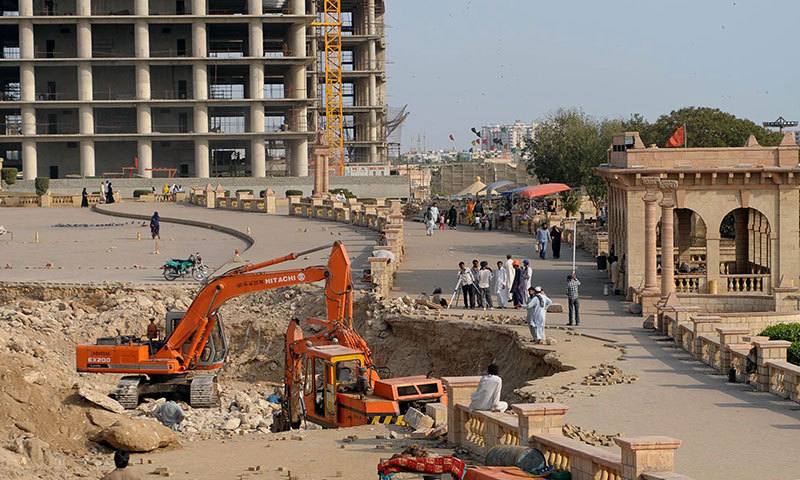
Year 2015 saw a mixed economic picture, as the government managed to bring stability by exclusively focusing on indicators that could readily add to strengthening the economy, yet failed to deliver in areas critical for placing it on strong footing.
Despite giving stability, it could not lay the foundation for sustainable economic development. The poor performance on investment, savings and exports front remained poor, deepening its dependence on foreign lenders to run economic and financial affairs.
Budget 2015-16: Govt eyes 5.5% GDP growth next year
Disservices
Like the previous year, the federal government remained defensive in 2015 as a result of not fulfilling its commitments on achieving specific targets under the $6.2 billion International Monetary Fund (IMF) programme. It kept on running the economy by making monthly plans and in the process implemented policies that suffocated growth, increased unemployment and income inequality.
These policies also further deepened the stigma of a ‘pro-rich government’; it taxed the daily usable goods while giving subsidies to sugar barons.
Furthermore, to meet its targets, the government resorted to an unprecedented level of taxation, affecting the poor and middle-income groups more than the rich.
On the last day of 2015, the government increased the rate of General Sales Tax (GST) on diesel to 51%, which is used to run agriculture tube-wells and in public transport (highest rate for any good).
Year-end special: A look back at 2015
Transparency in economic decision-making was visibly lacking. The government did not make public its negotiations with Qatar for the $16 billion Liquefied Natural Gas deal. Questions were also raised over the manner the government approved road infrastructure projects under the China Pakistan Economic Corridor (CEPC).
Unemployment rate jumped to a 13-year high of 8.3 %. Income inequality increased and the government again refused to release poverty data, which is increasing day by day. Investments and savings – the two fundamentals of strong economy – were ignored. Finance Minister Ishaq Dar rarely mentioned these two areas in his speech. Exports could not pick despite the Generalised System of Preference (GSP) plus scheme
The top most priorities of the government remained building foreign currency reserves, largely by borrowings, and curtailing budget deficit by cutting development spending and parking expenses outside the budget.
As a result, the country’s total foreign currency reserves increased to historical level of $21.1 billion including $4.9 billion that are in the private hands.
Efforts that need to be praised
The increase in foreign reserves would allow the government to say adieu to the IMF in this year, providing much-needed space to take decisions ahead of the 2018 general elections.
Pakistan’s tricky foreign policy balancing act
Even if IMF prematurely suspends the programme and other international lenders stop budgetary support loans, the government will have sufficient foreign currency reserves to meet its international obligations for the next two years. However, Finance Minister Ishaq Dar would like to avail at least one more IMF tranche of $500 million.

The low crude oil prices in the international market and appreciation of US dollar against other global currencies helped the government build reserves. On these two accounts, the government saved $3 billion to $4 billion in the last year.
In 2015, the government also remained successful in saving the IMF programme and took some tough decisions during the course of the year. However, in the last couple of months, its commitment towards structural reforms weakened, which might derail the privatisation process in 2016.
On the fiscal front, the government successfully managed the budgetary books to the satisfaction of the IMF.
Independent economists expressed serious reservations over the manner in which the Finance Ministry handled the books. They levelled allegations of figure-fudging. However, IMF did not pay much heed to these accusations, preferring to look at the government with a tender heart.
Taxation again remained a weak area and the base could not be broadened. The government missed its budgetary tax collection targets but the price of inefficiency was paid by the fellow citizens in shape of increased burden of indirect taxation.
A statistical look into Pakistan’s foreign friendships
It also gave another amnesty scheme for traders to whiten their black money.
Though the power sector bleeding could not be stopped and the circular debt again piled up to Rs661 billion, including arrears parked in a power holding company, the Ministry of Water and Power did slightly improve bill collection and marginally reduced line losses.
Overall, the $46-billion China Pakistan Economic Corridor, Vision 2025 that gave long-term plans and US-Pakistan Knowledge Corridor can be described as high points of the PML-N government in 2015.
The writer is a staff correspondent
Published in The Express Tribune, January 4th, 2016.
Like Business on Facebook, follow @TribuneBiz on Twitter to stay informed and join in the conversation.

1721377568-0/BeFunky-collage-(18)1721377568-0-165x106.webp)





















COMMENTS (1)
Comments are moderated and generally will be posted if they are on-topic and not abusive.
For more information, please see our Comments FAQ